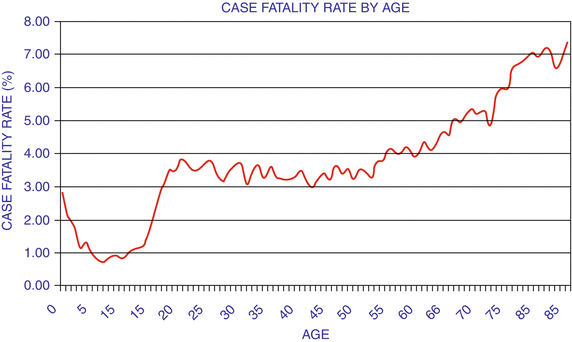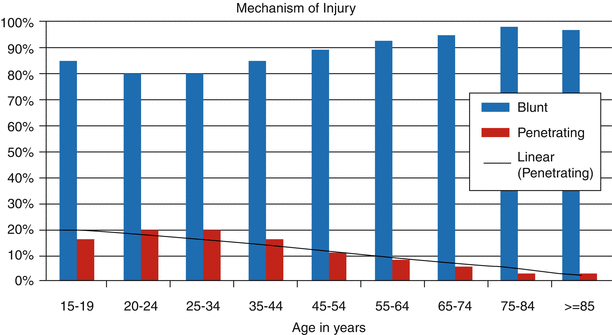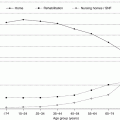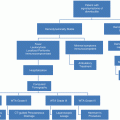Fig. 1.1
The administration on aging
The Cost of Caring for the Elderly
As the elderly population increases, the need for healthcare services and the cost of health care are expected to grow. The elderly represented 40 % of all hospitalized adults in 2008 [3]. Similarly, even though this population comprises only 13 % of the population of the United States, nearly half of all healthcare dollars spent are on the elderly. Additionally, the population over 85 years of age represents only 1.8 % of the total population but accounts for 8 % of all hospital discharges. Hospitalizations and healthcare spending for older adults are expected to rise as the geriatric population grows [4].
More healthcare resources will be necessary to care for the aging population which will pose an additional burden on an already-strained system. This cost will not only be reflected in dollars but in resource utilization including acute and long-term care. In 2002, the elderly made up 13 % of the US population, but they consumed 36 % of the total US personal healthcare expenses. The average healthcare expense in 2002 was $11,089/year for elderly people but only $3,352/year for those younger than 65 years [5]. Furthermore, older Americans spend 13.2 % of their total expenditures on health, more than twice the proportion spent by the younger citizens (6.6 %) [2]. The five most expensive illnesses include heart disease, cancer, trauma, mental disorders, and pulmonary conditions. Heart disease and trauma ranked first and second as the two costliest diseases in terms of total healthcare spending [6].
Thirty percent of total Medicare payments each year are for 6 % of the beneficiaries who died that year. Payments for the last 60 days of life constitute 52 % of the total dollars spent annually by Medicare. Inpatient services consume 70.3 % of the Medicare budget of which the majority of the funds are spent on critical care [7]. In summary, the sickest, eldest patients with a high incidence of morbidity and mortality consume the majority of the Medicare budget [8].
Effects of Aging on Organ Function
Understanding the medical physiology pertinent to this population is particularly important, because it affects the physiologic reserve and compensatory mechanisms required to respond to a traumatic injury, an acute illness, and major operations. The elderly population has a high incidence of comorbidities which can confound the physicians’ ability to assess for injury. In injured geriatric patients, the incidence of preexisting medical conditions is 66 %. Moreover, 81 % of nonagenarians have medical comorbidities [9]. Nearly every organ system is affected by changes due to aging. A detailed discussion of this is beyond the scope of this chapter, but a brief synopsis follows.
Traumatic brain injury (TBI) has a bimodal age distribution, with the first peak at 15–19 years and the second appearing in those over 65 years of age. The most common cause of TBI in older patients is falling from standing. Despite this low-energy mechanism, the brain is more susceptible to injury due to the progressive volume loss and atrophy that results in space for shear injury [10]. Elderly patients with traumatic brain injuries have worse outcomes when compared to similar injuries in the young [11]. Cardiovascular changes that occur in this population include arterial atherosclerosis which can lead to an elevation in baseline SVR. Disruption in coronary autoregulation from scarring can result in ischemia. The typical tachycardia in response to hypovolemia may also be blunted in these patients due to medications. The increase in SVR may produce a falsely elevated blood pressure. If these patients are chronically hypertensive, a normal SBP may be relatively hypotensive for an individual patient and may result in end-organ ischemia [12]. The effect of age on the pulmonary system is impaired gas exchange due to a reduced alveolar surface area [13]. Chest wall compliance is decreased and may result in a blunted cough reflex leading to increased risk for aspiration [14]. There is also a risk for renal failure following trauma. The renal tubular function declines with increasing age as indicated by a decrease in the glomerular filtration rate (GFR). Chronic diuretic use may predispose to electrolyte abnormalities and a contracted plasma volume. The collecting tubules may not concentrate or retain appropriate electrolytes and is at risk for acute kidney injury/failure due to medications and/or ischemia [15]. Changes in the gastrointestinal system result in increased reflux disease and dysphagia resulting in a higher risk for aspiration in the elderly. Aging causes a slower transit time and colonic disturbances ranging from constipation to diarrhea. The musculoskeletal system is also affected. Lean body mass decreases at a rate of 10 % per decade after the age of 50. The reduction in the number and size of myocytes results in progressive weakness with increasing age. This loss of muscle mass combined with osteoporosis leads to an increase risk of fall-related fractures. Hip fractures are a common injury in the elderly and result in an eightfold increase in all-cause mortality within 3 months after the fall [16]. The endocrine and immune systems are also affected by aging. Extensive hormonal changes occur and thermoregulation may be impaired. Elderly patients are also more susceptible to infections and concomitantly are less able to mount a normal immune response. Moreover, malnutrition is common in the elderly requiring nutritional supplementation to prevent profound catabolism [17]. In summary, every organ system is affected by aging and predisposed to injury, infection, and disability. Medications for preexisting illnesses may also complicate the physiologic response to injury and resuscitation. It is paramount to take these changes into consideration when caring for a geriatric trauma patient.
The functional decline that occurs with aging can lead to an increase in traumatic injuries due to changes in the ability to do activities of daily living (ADLs). ADLs include bathing, dressing, eating, and mobilization. They are important in assessing an individual’s ability to function independently. In noninstitutionalized Medicare recipients, 27 % had difficulty in performing one or more ADLs. The ability to conduct ADLs is worse for institutionalized recipients, and 95 % reported difficulties with one or more activity. Additionally, 74 % of those surveyed had difficulty with three or more activities. Limitations in ADLs related to chronic conditions increase with age and can predispose to traumatic injuries [2]. An increase in the frequency of ground level falls in this group can reflect a decline in the ability to perform daily activities. This decline in their ability to perform ADLs suggests that the elderly may become more prone to injuries with advancing age.
Trauma in the Elderly
Trauma is the fifth most common cause of death in the elderly. The mechanism of injury in this demographic is primarily blunt forces, and falls are the most common mechanism of injury in this group (Figs. 1.2 and 1.3) [1]. The increase in life expectancy and independent living will lead to an increase in elderly drivers. It is estimated that between 20 and 30 million licensed drivers are currently older than 65 [18]. This number is projected to increase to 50 million by 2030. This explosion in geriatric drivers will be associated with an increase in motor vehicle collisions and/or pedestrians struck and result in an increase in the mortality rate.


Fig. 1.3
Selected mechanisms of injury by age (NTDB® Annual Report 2010)
The geriatric trauma population poses a special challenge to the trauma team. The mechanism of injury is different than those seen in younger patients. Several studies have reported an age-related increase in mortality rates for all injury mechanisms and ISS scores (see Fig. 1.4) [19–21].


Fig. 1.4
Case fatality rate by age (NTDB® Annual Report 2010)
Multiple mechanisms that result in trauma exist in the elderly population. Of those patients that fall, it is usually a repeated occurrence and 71 % of falls result in an injury requiring medical care [22]. Additional mechanisms of blunt trauma include motor vehicle collisions, pedestrians struck, and burn injuries. According to the NTDB, <5 % of deaths are due to penetrating injuries in this age group [23]. Elderly patients who sustain blunt chest trauma with rib fractures have a morbidity and mortality rate twice that compared to those younger than 65. For each additional rib fracture in the elderly, mortality increases by 19 % and the risk of pneumonia by 27 % [24]. Moreover, when considering rib fracture injuries, “elderly” has been shown to be as young as 45 and older [25]. Clinical pathways that aggressively treat the pain and attempt to prevent the respiratory complications have shown to be successful [21].
Once an elderly person is injured, the trauma system is not reliable in identifying those that are severely injured. This is primarily a difficulty in triage of these patients. Demetriades et al. found that 63 % of elderly patients that were severely injured (ISS >15) and 25 % of those critically injured did not meet the trauma center’s standard trauma activation criteria. They concluded that patients older than 70 years should be considered for trauma team activation based on age alone [26, 27]. The EAST guidelines recommend that geriatric patients should be triaged to a trauma center, but do not use age as an impetus to activate the trauma team [28]. The state of Ohio has implemented a specific geriatric triage based on age [29]. Furthermore, once the elderly are in the emergency department, they may not be easily identified as in shock. Physiologic changes that occur in the elderly may alter the typical physiologic signs and manifestations of shock. Scalea et al. studied patients older than 65 involved in motor vehicle collisions and found their physiology allowed them to present with a higher than expected systolic blood pressure (SBP) due to an elevated systemic vascular resistance (SVR). Of those initially deemed stable with a normal SBP at presentation, 43%were found to actually be in cardiogenic shock and 54 % of these patients died [30]. Accordingly, base deficit may correlate better with mortality in the elderly trauma population. In those older than 55 years, a base deficit greater than ten was associated with an 80 % mortality rate. In contrast, a base deficit between three and five is equivalent to 23 % mortality [31]. Geriatric blunt trauma patients warrant increased vigilance despite normal vital signs on presentation. It has been suggested that criteria for the elderly include a heart rate greater than 90 or a systolic blood pressure less than110 mm [32].
Additionally, medications taken prior to admission can confound the diagnosis of significant injury as well as the resuscitation of these patients. Over 80 % of patients that fall are on a drug that could have contributed to the fall including antidepressants, antihypertensives, and sedatives [33]. Beta blockers prescribed for hypertension can blunt the normal tachycardic response to hemorrhage resulting in a false sense of security that the patient is stable. Anticoagulants, including warfarin, Plavix, and aspirin, can result in increased bleeding. This can be especially detrimental when traumatic brain injuries are present and expeditious reversal should occur. Those that do present on these anticoagulation medications have a higher risk of death [34].
Furthermore, delirium may also add to the difficulty in assessing this demographic of injured patients in the emergency department. Delirium affects up to 10 % of elderly patients in the emergency department and can confound assessment of these patients. Delirium is often the first presentation of sepsis in the elderly and is unrecognized which may lead to an increase in mortality [14]. As early sepsis can result in falls and therefore traumatic injuries, sepsis screening in the emergency department should be implemented early in these patients [35].
Once admitted to the hospital, geriatric patients pose a unique challenge to the trauma service due to their abnormal response to shock and injury. Bradburn et al. established a geriatric protocol that significantly reduced mortality in their patient population. The protocol included a geriatric consultation, a lactate level, arterial blood gas, and echocardiogram [36]. An additional study by Lenartowicz et al. showed that a proactive geriatric consultation resulted in decreased delirium and discharges to long-term care facilities [37].
In a large series of elderly patients, mortality was demonstrated to correlate closely with ISS. It was also influenced by blood and fluid requirements as well as the GCS score. Regression analysis revealed that ISS predicted adult respiratory distress syndrome, pneumonia, sepsis, and gastrointestinal complications; fluid transfusion predicted myocardial infarction; and need for surgery and transfusion requirements predicted sepsis. These complications, in turn, were significant risk factors for mortality [20].
Early Inpatient Rehabilitation
Weakness associated with impaired function is commonplace in the injured elderly. Admission to the intensive care unit (ICU) often results in increased muscle weakness, and the need for short- and long-term rehabilitation is frequent. Implementing early physical therapy in the ICU can result in increased strength as well as decreased length of ICU and hospital stay. More importantly, preventing core muscle wasting and preserving strength can reduce mortality [38].
Stay updated, free articles. Join our Telegram channel

Full access? Get Clinical Tree







